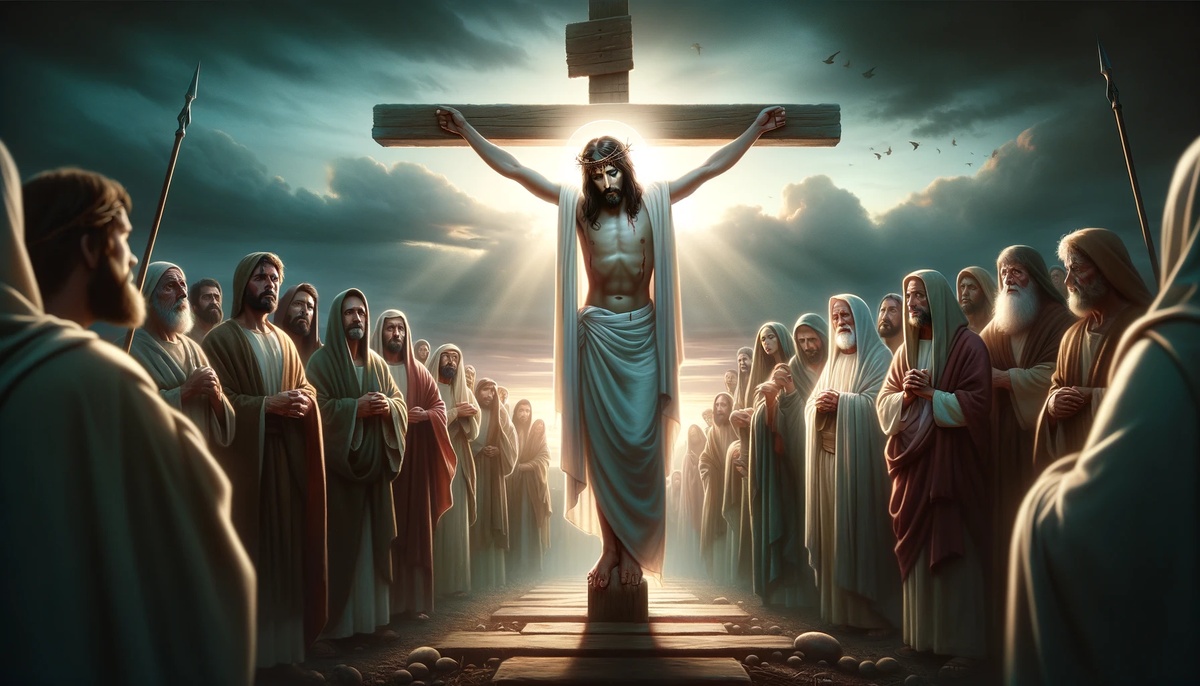Home>Christian Videos>Bible Stories>Why Do People Hate Jesus Christ


Bible Stories
Why Do People Hate Jesus Christ
Published: March 1, 2024
Jason DeRose, Managing Editor at Christian.net, uses his expertise in religion and journalism to deepen understanding of faith's societal impacts. His editorial leadership, coupled with a strong academic background, enriches the platform’s diverse content, earning him recognition in both journalism and religious circles.
Discover the reasons behind the animosity towards Jesus Christ and explore the impact of Bible stories on people's perceptions. Uncover the truth about the controversial figure.
(Many of the links in this article redirect to a specific reviewed product. Your purchase of these products through affiliate links helps to generate commission for Christian.net, at no extra cost. Learn more)
Table of Contents
The Misconceptions about Jesus Christ
There are several misconceptions about Jesus Christ that have led to feelings of hatred towards him. These misconceptions often stem from a lack of understanding or misinformation about his teachings and life. Here are some of the common misconceptions about Jesus Christ:
-
Misunderstanding of His Message: Many people misunderstand the core message of Jesus Christ, which is one of love, compassion, and forgiveness. Some individuals may perceive his teachings as restrictive or judgmental, leading to a negative view of him.
-
Association with Religious Hypocrisy: Some individuals associate Jesus Christ with the hypocrisy and corruption that has been observed in certain religious institutions. This association can lead to resentment towards him, as he is seen as a symbol of institutionalized religion rather than a spiritual teacher.
-
Perceived as a Threat to Personal Beliefs: For some, Jesus Christ is seen as a threat to their personal beliefs or way of life. This can lead to hostility towards him, as individuals may feel that his teachings challenge their own values and ideologies.
-
Misrepresentation in Popular Culture: The portrayal of Jesus Christ in popular culture, literature, and media has sometimes been inaccurate or sensationalized. This misrepresentation can contribute to a distorted view of him, leading to negative perceptions.
-
Historical and Cultural Misinterpretations: Throughout history, Jesus Christ has been interpreted and depicted in various ways across different cultures and time periods. These interpretations may not always align with the true essence of his teachings, leading to misconceptions about his character and intentions.
Addressing these misconceptions and gaining a deeper understanding of Jesus Christ and his teachings can help to dispel feelings of hatred towards him. It is important to approach the subject with an open mind and a willingness to learn about the historical and spiritual significance of Jesus Christ.
Read more: Why Do So Many People Hate Catholicism
The Historical Context of Jesus Christ
Understanding the historical context of Jesus Christ is crucial in comprehending the reasons behind the animosity towards him. The time period in which Jesus lived, known as the 1st century AD, was characterized by social, political, and religious upheaval. Here are some key points to consider when examining the historical context of Jesus Christ:
-
Roman Occupation: During Jesus' lifetime, the region of Judea was under Roman occupation. The presence of Roman authority and the imposition of Roman laws and customs created tension and resistance among the Jewish population. Jesus' teachings of spiritual liberation and the Kingdom of God may have been perceived as a challenge to Roman rule, leading to conflict and opposition.
-
Jewish Religious Landscape: Within the Jewish community, there were diverse religious sects and movements, each with its own interpretations of Jewish law and tradition. Jesus' teachings, which often diverged from the established religious norms, sparked controversy and division among the religious leaders and the populace. His radical message of inclusivity and compassion challenged the existing religious hierarchy, provoking hostility from those in power.
-
Messianic Expectations: The 1st century was rife with messianic expectations among the Jewish people. Many anticipated the arrival of a messianic figure who would deliver them from oppression and establish a new era of righteousness. Jesus' claim to be the long-awaited Messiah, coupled with his unconventional methods and teachings, incited skepticism and opposition from those who held different expectations of the Messiah.
-
Cultural and Societal Norms: The cultural and societal norms of the time influenced the reception of Jesus' message. His interactions with marginalized groups, such as tax collectors, sinners, and women, challenged the prevailing social hierarchies and norms. This unconventional approach may have been perceived as subversive and disruptive, leading to resentment from those who upheld traditional social structures.
-
Historical Documentation: The historical documentation of Jesus' life and teachings, primarily found in the New Testament of the Bible, has been a subject of scholarly debate and scrutiny. The interpretation and reliability of these historical accounts have contributed to differing perspectives on the figure of Jesus Christ, leading to varying attitudes and beliefs about him.
Examining the historical context of Jesus Christ provides valuable insights into the complexities of his time and the factors that contributed to the animosity directed towards him. It underscores the interplay of political, religious, and social dynamics that shaped the reception of his message and ultimately influenced the attitudes towards him.
The Influence of Religious Institutions
-
Doctrinal Differences: Religious institutions, with their diverse doctrinal beliefs and practices, have played a significant role in shaping the perceptions of Jesus Christ. The theological interpretations and teachings propagated by these institutions have often led to contrasting views of Jesus, contributing to discord and animosity among different religious groups. The doctrinal differences regarding the nature of Jesus, his role in salvation, and his relationship to God have been a source of theological tension, influencing how individuals perceive and relate to Jesus Christ.
-
Historical Conflicts and Schisms: Throughout history, religious institutions have been embroiled in conflicts and schisms, leading to the polarization of beliefs and attitudes towards Jesus Christ. The historical divisions within Christianity, such as the Great Schism between the Eastern Orthodox Church and the Roman Catholic Church, as well as the Protestant Reformation, have fostered distinct theological perspectives and allegiances. These schisms have contributed to the perpetuation of animosity and distrust towards differing interpretations of Jesus Christ within the context of religious institutions.
-
Institutional Authority and Control: The authority and control exerted by religious institutions over the spiritual lives of their adherents have influenced the perception of Jesus Christ as a central figure within their respective faith traditions. The institutional hierarchy, religious leadership, and doctrinal enforcement have shaped the portrayal of Jesus and his teachings, often aligning with the interests and agendas of the religious authorities. This influence has, at times, resulted in the suppression of alternative interpretations of Jesus and the marginalization of dissenting voices within religious communities.
-
Doctrinal Purity and Orthodoxy: The emphasis on doctrinal purity and orthodoxy within religious institutions has contributed to the exclusion and condemnation of divergent views of Jesus Christ. The preservation of theological orthodoxy, as defined by religious authorities, has led to the stigmatization of interpretations that deviate from established norms. This enforcement of doctrinal conformity has perpetuated a climate of intolerance and hostility towards individuals or groups who espouse alternative understandings of Jesus Christ, further fueling animosity within religious contexts.
-
Interfaith Relations and Dialogue: The interactions between religious institutions of different faith traditions have also influenced the perceptions of Jesus Christ on a broader interfaith level. Interfaith relations, characterized by dialogue, cooperation, or conflict, have impacted the portrayal of Jesus within the context of diverse religious communities. The varying degrees of acceptance, rejection, or reinterpretation of Jesus Christ across different religious traditions have contributed to the complex tapestry of attitudes towards him, reflecting the interplay of religious institutional influences.
Understanding the influence of religious institutions is essential in comprehending the multifaceted dynamics that have shaped the perceptions of Jesus Christ. The interplay of doctrinal differences, historical conflicts, institutional authority, doctrinal purity, and interfaith relations within religious contexts has significantly impacted the attitudes and animosity directed towards Jesus Christ.
The Personal Beliefs and Experiences of Individuals
-
Cultural Upbringing: The personal beliefs and experiences of individuals are profoundly influenced by their cultural upbringing. The cultural milieu in which individuals are raised shapes their perceptions of Jesus Christ. Different cultural narratives, traditions, and societal norms contribute to diverse interpretations of Jesus, leading to a spectrum of attitudes towards him.
-
Religious Upbringing and Indoctrination: The religious upbringing and indoctrination of individuals within specific faith traditions significantly impact their beliefs about Jesus Christ. The teachings and narratives imparted within religious communities shape the lens through which individuals perceive Jesus. The doctrinal emphasis, religious rituals, and spiritual education within these contexts contribute to the formation of personal beliefs and experiences related to Jesus Christ.
-
Personal Encounters and Experiences: Personal encounters and experiences with individuals of diverse religious backgrounds, as well as with representations of Jesus in art, literature, and media, play a pivotal role in shaping personal beliefs about Jesus Christ. These encounters may evoke feelings of admiration, skepticism, or aversion, influencing the individual's perception of Jesus.
-
Existential and Spiritual Quest: The existential and spiritual quest of individuals leads to diverse interpretations and experiences related to Jesus Christ. The search for meaning, purpose, and transcendence prompts individuals to engage with the figure of Jesus in ways that resonate with their innermost yearnings and aspirations. This quest often results in a deeply personal and subjective understanding of Jesus Christ.
-
Cognitive and Emotional Associations: The cognitive and emotional associations individuals form with the figure of Jesus Christ contribute to their personal beliefs and experiences. Positive or negative emotional associations, cognitive dissonance, and psychological factors influence the individual's stance towards Jesus. These associations are often intertwined with personal experiences, upbringing, and social interactions.
-
Philosophical and Intellectual Inquiries: Philosophical and intellectual inquiries into the historical, theological, and ethical dimensions of Jesus Christ shape the beliefs and experiences of individuals. The exploration of religious texts, philosophical discourse, and critical analysis fosters diverse perspectives on Jesus, influencing the individual's intellectual and existential engagement with his figure.
Understanding the personal beliefs and experiences of individuals is essential in comprehending the diverse and nuanced attitudes towards Jesus Christ. The interplay of cultural upbringing, religious indoctrination, personal encounters, existential quests, cognitive and emotional associations, and intellectual inquiries contributes to the multifaceted landscape of beliefs and experiences related to Jesus Christ.
The Cultural and Societal Factors
-
Cultural Diversity: The rich tapestry of cultural diversity across the globe has contributed to a wide array of attitudes towards Jesus Christ. Different cultures have interpreted and integrated the figure of Jesus into their belief systems, folklore, and traditions, resulting in diverse representations and perceptions of him. This cultural diversity has given rise to a spectrum of attitudes, ranging from reverence and adoration to skepticism and indifference, reflecting the multifaceted nature of cultural influences on the perception of Jesus Christ.
-
Societal Norms and Values: The prevailing societal norms and values within specific communities have shaped the attitudes towards Jesus Christ. Societal expectations, moral frameworks, and ethical standards influence how individuals perceive the teachings and character of Jesus. The alignment or dissonance between Jesus' message and the societal norms of compassion, justice, and altruism has impacted the reception of his figure within different social contexts, contributing to varying attitudes towards him.
-
Historical Legacies and Traditions: The historical legacies and traditions of societies have left enduring imprints on the perceptions of Jesus Christ. The intergenerational transmission of beliefs, customs, and historical narratives has influenced the portrayal of Jesus within specific cultural and societal frameworks. Historical events, religious movements, and cultural milestones have contributed to the shaping of attitudes towards Jesus, reflecting the enduring impact of historical legacies on the contemporary understanding of his figure.
-
Artistic and Literary Representations: Artistic and literary representations of Jesus Christ have played a pivotal role in shaping cultural and societal attitudes towards him. The diverse depictions of Jesus in visual arts, literature, music, and popular culture have evoked varied emotional and intellectual responses from different audiences. These representations have contributed to the formation of cultural archetypes and symbols associated with Jesus, influencing the collective consciousness and perceptions of his figure within society.
-
Interfaith Dynamics: Interfaith dynamics within multicultural societies have influenced the perceptions of Jesus Christ among diverse religious communities. The interactions, dialogues, and conflicts between different faith traditions have impacted the portrayal of Jesus within the broader interfaith context. The varying degrees of acceptance, rejection, or reinterpretation of Jesus Christ across different religious communities reflect the complex interplay of cultural and societal factors in shaping attitudes towards him.
-
Globalization and Information Exchange: The process of globalization and the exchange of information have facilitated the dissemination of diverse perspectives on Jesus Christ across different cultural and societal landscapes. The interconnectedness of the modern world has led to the cross-pollination of beliefs, ideas, and interpretations related to Jesus, contributing to the evolving cultural and societal attitudes towards his figure. This global exchange of information has broadened the scope of cultural influences on the perception of Jesus Christ, reflecting the dynamic nature of cultural and societal factors in shaping attitudes towards him.
Understanding the cultural and societal factors that influence attitudes towards Jesus Christ is essential in recognizing the diverse and dynamic nature of his reception within different cultural and societal contexts. The interplay of cultural diversity, societal norms, historical legacies, artistic representations, interfaith dynamics, and globalization underscores the multifaceted landscape of attitudes towards Jesus Christ, reflecting the complex tapestry of cultural and societal influences on his figure.















